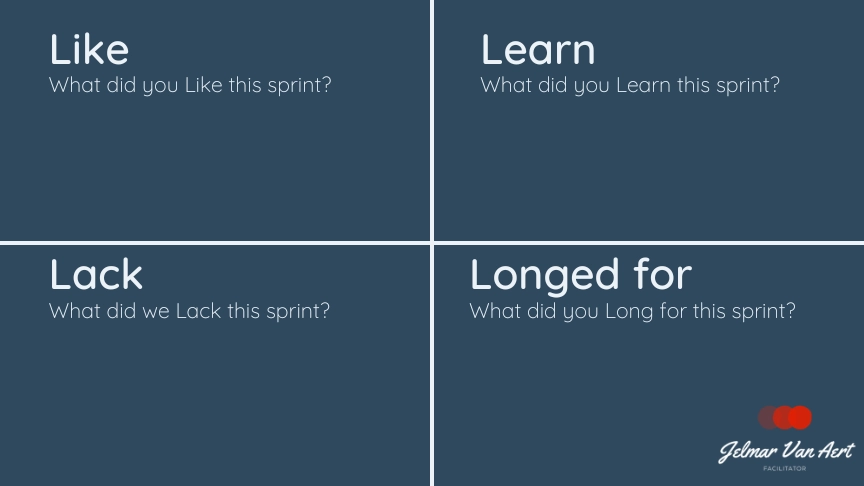Liked, Learned, Lacked, Longed for: Your guide to the 4L Retrospective.
Liked, Learned, Lacked, Longed for: Your guide to the 4L Retrospective.
What is the 4 ls retrospective technique?
The 4 Ls retrospective stands for Liked, Learned, Lacked, and Longed for. It's an easy-to-use template you can run with your agile teams. The goal is to gather feedback and make necessary adjustments as a team.
The 4 sections of the retrospective prompts each team member to gather feedback. This conversation-focused retrospective helps you to bring the team on the same page to make future improvements.
How to run a 4 ls retrospective?
Prepare (5 min)
Before you start a retrospective, you better come prepared. Don't worry, it won't take you long!
We need space to gather sticky notes from our team members for each section of the 4L retrospective. Draw four boxes and title them with Liked, Learned, Lacked, Longed for. Make sure there is enough space to host all the sticky notes.

For remote teams, you can easily use Miro or other whiteboard tools.
Introduce the 4L retrospective (10 min)
Introduce the 4L retrospective to the team. Show them what they'll be focussing on during the retrospective.
You can now gather expectations from the team about the retrospective. This is important to set the right expectations. Setting and Getting expectations is a powerful technique for running successful retrospectives.
Another option is to do an icebreaker exercise with the team.
Here is how I introduce the 4L retrospective to my teams.
Hi team,
Today we are going to use the 4ls retrospective. Yes, I know, we are switching it up once again.
The workshop will take around 90 minutes and we'll be focussing on 4 diffrent questions I've prepared for you. Be aware that we are not only going to focus 90 minutes on the 4l's but we'll also need some time to create actionable items for our team.
Now before we get started, are there any questions?
Capture the responses from your team members (15 min)
Now that we've set the stage, it's time to get into the retrospective.
Ask your team to think about the following questions:
- What did you like during our last sprint?
- What did you learn from the last sprint?
- What did we lack during the last sprint?
- What did you long for during the last sprint?
Make sure they work alone together. This means no talking until the timer runs out. There will be plenty of time left during the retrospective to discuss some topics. We are now just in the capturing phase.
Create action items (15 min)
Now, discuss in the team or in breakout groups what item we'll remove from the Lacked list and one item from the Liked list to amplify in the next sprint. Let them brainstorm ideas.
You can use the What, So What, Now What liberating structure to guide the conversation.
Take the items from the Learn and Longed for list as inspiration to create action items.
Capture the action plan (15-25 min)
Let every group share their action items with the rest of the team. Decide if the action is worth taking with the group. You can use an effort impact scale on all of the action items if needed.
Don't forget to write who will do it. What they'll be working on and by when.
Conclusion
The 4 L's retrospective is an effective tool for agile teams to gather feedback and make necessary adjustments. It gives you, the scrum masters, a way to capture the emotional perspective of your team.
This retrospective helps to identify areas of strength and those that require improvement of their past performance.
By following the four steps outlined in this guide, your team can conduct a successful retrospective and develop an actionable plan for future sprints.
Remember to set the right expectations to capture objective feedback, work alone together during the capturing phase, and assign action items to team members with timelines for completion.
The 4 L's retrospective can be used to optimize teamwork and improve the overall efficiency of your agile team.

